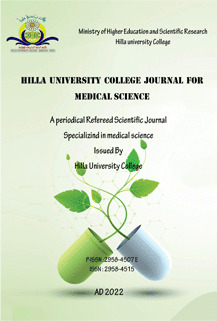Abstract
Background: Amebiasis can cause a number of symptoms, from infections that are passed on when someone touches
something infected to serious illness.
Objectives: role of DMF on reducing Entamoeba histolytica (E. histolytica) infection.
Materials and Methods: The study involved patients supplying E. histolytica-related symptoms. Diagnoses were confirmed using stool samples, and 10 mL of venous blood was obtained for antioxidant and immunological investigation.
Groups: Control (uninfected patients), Normal medication (infected patients on normal medication), and Combination
(infected patients getting standard treatment with DMF).
Results: Group 2 and 3 had lower red blood cell and haemoglobin levels than group 1. Group 2 was different from
groups 1 and 3 (P < 0.05), which shows that DMF reduces red blood cell and haemoglobin loss. Group 1 had higher levels
of different types of white blood cells, including neutrophils, monocytes, and eosinophils. Group 1 had lower amounts of
lymphocytes compared to groups 2 and 3. Statistical analysis showed a significant decrease in SOD, GSH, and CAT levels
in patients receiving E. histolytica standard treatment compared to the healthy control group, while malondialdehyde
levels increased a lot (P ≤ 0.05) in the same group. Group 3 showed a significant increase (P ≤ 0.05) in SOD, GSH, and
CAT levels compared to the standard therapy group, while malondialdehyde levels increased significantly in patients
treated with E. histolytica standard therapy plus DMF.
Conclusion: E. histolytica infection has been found to generate leukocytosis, lower antioxidant levels, and boost MDA.
It is advised that a potent antioxidant be added to conventional treatment.
something infected to serious illness.
Objectives: role of DMF on reducing Entamoeba histolytica (E. histolytica) infection.
Materials and Methods: The study involved patients supplying E. histolytica-related symptoms. Diagnoses were confirmed using stool samples, and 10 mL of venous blood was obtained for antioxidant and immunological investigation.
Groups: Control (uninfected patients), Normal medication (infected patients on normal medication), and Combination
(infected patients getting standard treatment with DMF).
Results: Group 2 and 3 had lower red blood cell and haemoglobin levels than group 1. Group 2 was different from
groups 1 and 3 (P < 0.05), which shows that DMF reduces red blood cell and haemoglobin loss. Group 1 had higher levels
of different types of white blood cells, including neutrophils, monocytes, and eosinophils. Group 1 had lower amounts of
lymphocytes compared to groups 2 and 3. Statistical analysis showed a significant decrease in SOD, GSH, and CAT levels
in patients receiving E. histolytica standard treatment compared to the healthy control group, while malondialdehyde
levels increased a lot (P ≤ 0.05) in the same group. Group 3 showed a significant increase (P ≤ 0.05) in SOD, GSH, and
CAT levels compared to the standard therapy group, while malondialdehyde levels increased significantly in patients
treated with E. histolytica standard therapy plus DMF.
Conclusion: E. histolytica infection has been found to generate leukocytosis, lower antioxidant levels, and boost MDA.
It is advised that a potent antioxidant be added to conventional treatment.
Keywords
Amebiasis
Di-Methyl fumarate
diarrhea
Entamoeba histolytica
inflammatory
